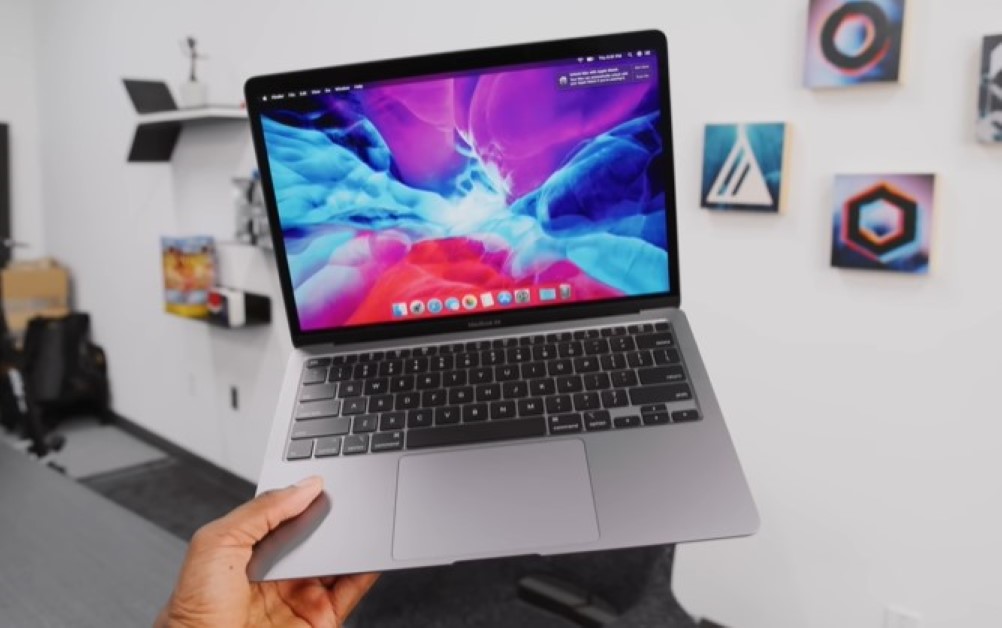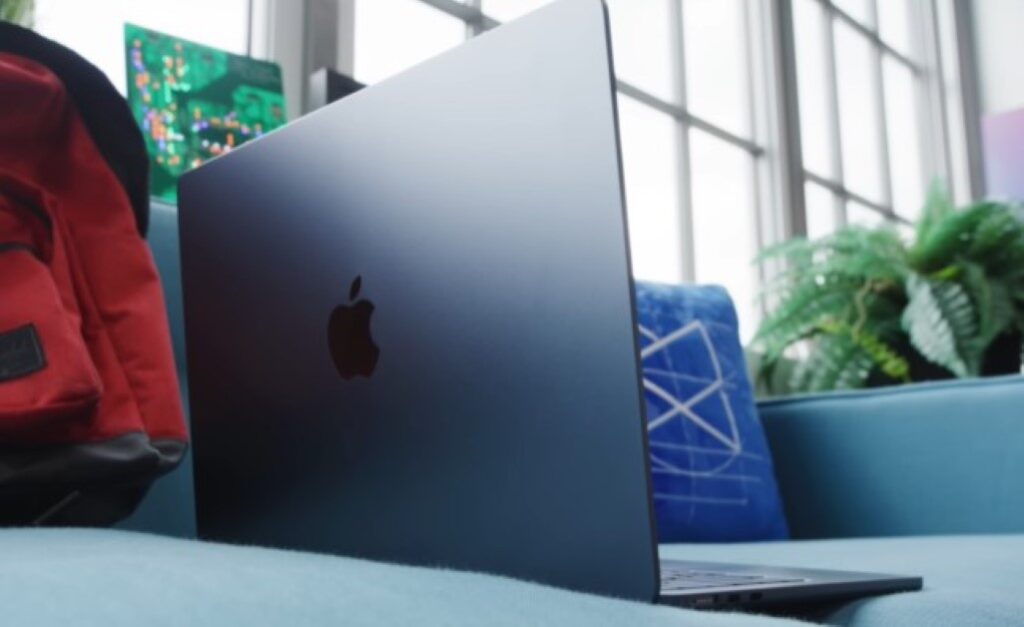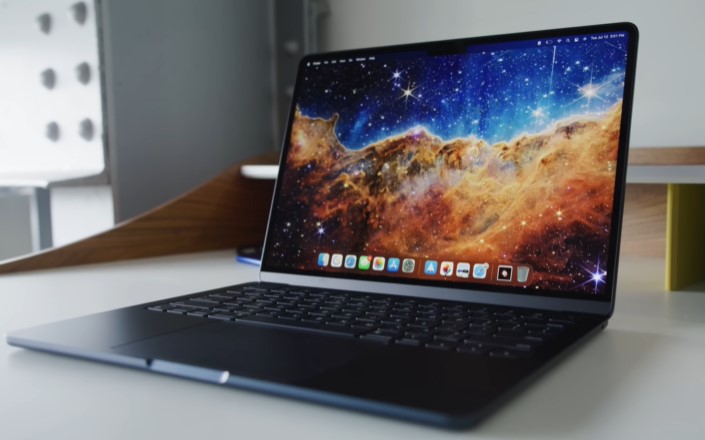Some people claim its thermal performance and SSD speed hold it back. I’ve used both the base model and the 16GB RAM version for 9 months, running benchmarks, battery life tests, thermal checks, and heavy daily use. The results were surprising. For better comparison, I also tested it against a thin-and-light Windows laptop and a 14-inch MacBook Pro.
Design and Display Quality

The redesigned M2 Air is a big step forward. It’s now flat instead of wedge-shaped, giving it a clean, modern look. There are no labels or markings on the body, but maybe Apple went a little too far by removing the speaker grills. The speakers are now hidden in the hinge area. While the audio quality is still excellent (especially compared to most Windows laptops), the treble isn’t as clear as the MacBook Pro, which still has top-firing speaker grills.
The display is also a highlight. The bezels are thinner, the screen is larger, and it’s brighter—up to 500 nits—matching the 14- and 16-inch MacBook Pros for SDR content. The anti-reflective coating works well indoors, even next to big windows, but direct sunlight outdoors makes visibility tough. The 2K resolution gives excellent sharpness, and the new 10-bit panel improves colors slightly, though not dramatically. Overall, it’s one of the best laptop screens—great for work, content, and with a comfortable 16:10 aspect ratio.
The “Midnight” color, a dark blue-black that shifts with the light, looks stunning but picks up fingerprints easily. If you like it, be prepared to wipe it down often. The slim bezels also include a centered notch. Personally, it doesn’t bother me and I got used to it quickly, but if it does annoy you, an app called Top Notch can hide it. The Air now includes a 1080p camera with clear video and low noise in good lighting, plus very good built-in mics.
The Magic Keyboard and Force Touch trackpad are unchanged from the last generation and remain excellent. The trackpad gives uniform clicks unlike most Windows laptops. The MacBook Air includes MagSafe, two USB-C ports, and a headphone jack, but only supports one external display. USB-C ports on both sides would’ve been better. Honestly, I rarely use MagSafe—USB-C charging is more convenient, and the Air charges quickly through it.

RAM, SSD and Heat

Apple Silicon handles memory differently than Intel systems. Even when RAM is maxed out, websites and apps open nearly instantly. On my 8GB unit, I rarely had reloads, and when it did happen, swap to SSD was so fast I barely noticed. By contrast, a Samsung laptop with 16GB slowed down noticeably.
So, if you’re considering upgrading RAM for heavy web browsing, it may not be necessary. Day-to-day, I didn’t see much difference between 8GB and 16GB. For video editing or photo exports, though, the extra memory can help—partly because the base model’s SSD is slower.
Upgrading the SSD improves performance since the smaller drive is about half the speed of the larger ones. That’s likely due to having just one NAND chip instead of two. Still, for everyday use—opening apps, or using external drives like USB sticks, SD cards, or HDDs—you probably won’t notice. Those drives are slower anyway, so file transfers don’t suffer.
Despite its power, heat isn’t a real issue. Even fanless, the M2 Air stays fairly cool. After 40 minutes of heavy use, it was about as warm as the 14-inch MacBook Pro. The keyboard tops out at 45°C, and the palm rest/trackpad around 35°C. Warm, but never uncomfortably so. For a silent laptop, the Air’s performance is impressive.
You can upgrade the GPU to 10 cores, but I don’t recommend it. Tasks that need GPU horsepower, like 3D rendering or serious video editing, aren’t the Air’s strong suit. If you need that, get the MacBook Pro. For most people, the 8-core GPU is more than enough. One last note: make sure your apps are Apple Silicon-compatible. If not, they’ll run through Rosetta with only a small performance hit.
M2 Air Performance

Performance is the heart of any laptop. And while the Air isn’t aimed at pros, its speed is shocking. Both the base and 16GB models easily beat my 14-inch MacBook Pro with M1 Pro in many everyday tasks. In Photoshop, for example, the Air consistently finishes filters faster. That’s because the M2 has stronger single-threaded performance than even the M1 Pro, Max, or Ultra—impressive, considering an M1 Max machine can cost three times as much.
The M2 Air shines in light and short tasks—the majority of what people actually do. I’m confident every bit of code I wrote in college would run faster here than on my M1 Pro MacBook Pro. Web-based work falls into this category too.
| Device | Browser |
|---|---|
| M2 MacBook Air | Chrome 281 |
| M2 MacBook Air | Safari 383 |
| 14′ MacBook Pro | Chrome 231 |
| Galaxy Book | Chrome 123 |
In benchmarks like Speedometer, the M2 Air even beats the 14-inch Pro. This speed translates to real life, loading heavy sites like Google Earth noticeably faster. For light workloads—web, light photo edits, programming without huge builds—the Air is actually faster than a fully loaded Pro.
With the new 24GB RAM option, it can even handle tougher multitasking like web development with tons of tabs. Compared to rivals like the Galaxy Book, the Air excels, especially in battery life, despite competing against higher-spec Intel chips like the i7-1260p with 16GB RAM.
| Device | Score |
|---|---|
| 13″ MacBook Air – M2 Base | 5635 |
| Galaxy Book i7 1260p | 1268 |
| 14″ MacBook Pro M1 Pro 10/16 | 10232 |
On graphics, the Air is 50% faster in web tasks and 400% faster in GPU-heavy work than the Galaxy Book. But the Galaxy Book’s fans spin constantly—even during 4K YouTube. The fanless Air does face thermal throttling in long GPU-intensive workloads, like video rendering. Performance drops after 5–6 minutes, but for everyday use you’ll barely notice.
I wouldn’t recommend the Air as a main video editing machine, but it can do the job. A 20-minute 4K video only took 9 minutes longer to export than the M2 MacBook Pro with a fan. Considering the Pro costs $200 more and has two extra GPU cores, the difference isn’t huge. Add a small cooling pad, and the Air can nearly match the Pro. Still, for serious heavy work, the M1 Pro MacBook Pro is a far better choice with more GPU cores and dual fans, cutting render times by more than half.
Battery Performance
| Device | hours & Minutes |
|---|---|
| 13″ MacBook Air – M2 Base | 14h 15min |
| Galaxy Book i7 1260p | 7h40 |
| 14″ MacBook Pro M1 Pro 10/16 | 10h |
The M2 Air has a bigger battery this year, bringing it closer to the Pros. In my testing, it lasted about 14h 50m in light use—video streaming and web browsing. In 4K video playback and web tasks, it outlasted the 14-inch Pro and nearly doubled the Samsung laptop, whose fans had to run constantly to stay cool. Both Macs, thanks to Apple Silicon’s efficiency, can last well over a day—or even two—on light use.
| Device | hours & Minutes |
|---|---|
| 13″ MacBook Air – M2 Base | 3h 48min |
| Galaxy Book i7 1260p | 3h |
| 14″ MacBook Pro M1 Pro 10/16 | 1h 35min |
Under heavy load, the Air lasted 3h 48m, which sounds short, but that was during an extreme stress test—something most users will never see. Only tasks like big code compilations or long video renders push it that hard. The Air lasted this long partly because it throttled performance to save power—not ideal, but effective.
Surprisingly, the Samsung laptop lasted too, but only because it slashed performance when unplugged, delivering just a fraction of the Air’s speed. The 14-inch Pro drains faster under load since its fans let it push more power to the chip, but it also finishes work faster. Overall, the Air’s battery life is excellent.
It also charges quickly—about an hour with a fast charger. It supports up to 70W charging via MagSafe or USB-C. Note: the 8-core CPU/8-core GPU model ships with a 30W adapter, so it charges slower. Still, the matching braided MagSafe cable is a nice touch.
Conclusion
The M2 MacBook Air isn’t just an entry-level or light-duty laptop. Despite SSD and thermal limitations, it outpaces the latest Intel laptops—and even beats my M1 Pro MacBook Pro in many daily tasks. It delivers a fast, smooth experience, all in a thin, light design with excellent battery life.
While it’s not the best for heavy video editing or 3D rendering, it’s still a speedy machine that will stay fast for years. With its new design and strong performance, it’s the perfect choice for a lot of people.
